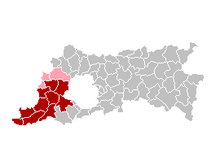Pajottenland
The Pajottenland is a hilly, fertile, agricultural region southwest of Brussels in the province of Flemish Brabant ( Belgium ).
Geography and geology
The Pajottenland is limited:
- in the north on the Bellebeek, which flows into the Dender in Denderleeuw ;
- in the east at the Zenne ;
- in the south through the Mark , which also flows into the Dender;
- in the west by the dender.
The lowest point in the region is the Zenne valley. The characteristic hilly landscape is reflected in hills with names like Ledeberg, Kongoberg, Suikerenberg, Eisberg, Snikberg, Tomberg, Tuitenberg, Zwijnenberg and even Putberg. The highest point at 112 m is the Kesterberg. In 1988 a hole was drilled. The upper layer of clay was no older than 20,000 years. A 500 million year old layer of solid quartzite was found over a distance of 125 m .
history
In the Middle Ages, two large dominions emerged , in the north the country Gaasbeek and in the south the country Enghien , to which the most important municipalities of the Pajottenland belonged. The Pajottenland is characterized by the absence of cities. It borders the cities of Brussels, Halle , Enghien, Geraardsbergen and, depending on the source, Aalst .
The Lenniker lawyer FJ De Gronckel drew attention to the Pajottenland by publishing a romantic and playful play entitled t Payottenland gelyk het van oudtyds gestaen en is (Brussels 1852) under the pseudonym Franciscus Josephus Twyfelloos.
Touristy
The Pajottenland and the Zennetal form the recognized regional landscape of Pajottenland & Zennevallei . The Pajottenland is also part of the Green Belt (Groene Gordel) around Brussels and is also called the Tuscany of the Low Countries or "Land of Bruegel ". Today it is best known for its regional product lambic and the drinks made from it, Faro , Kriek and especially Geuze . The region was world famous for its draft horses ( Brabantians ) from 1880 to 1950 . Towards the end of the 19th century and the beginning of the 20th century, the Belgian cold-blooded horses were exported all over the world and were henceforth often used for processing. The horse breed had a great influence on other cold blood breeds worldwide.
Communities
- Affligem with sub-municipalities Essene, Hekelgem and Teralfene.
Affligem became known through the Benedictine Abbey of Affligem , founded by Count Palatine Hermann II in 1062 , which for a long time was the most important abbey in Brabant as the house abbey of the Dukes of Brabant .
- Asse with the sub-municipalities of Bekkerzeel, Kobbegem, and Zellik.
In Aces are now hops darren (a kiln for drying hops ). Hop kiln is still alive in the folklore of the Asse and Aalst area, where hop culture used to flourish.
Bever is one of the Dutch-speaking communities with French facilities.
- Dilbeek with the sub-communities Groot-Bijgaarden, Itterbeek (with Sint-Anna-Pede), Schepdaal (with Sint-Gertrudis-Pede), Sint-Martens-Bodegem and Sint-Ulrikskapelle.
Jacques de Croÿ (around 1436–1516), Prince-Bishop of Cambrai , maintained a castle in Dilbeek in which he died
- Galmaarden with sub-municipalities Tollembeek and Vollezele.
In 2000 a museum for the Belgian draft horse opened in Vollezele.
- Gooik with sub-municipalities Gooi (with Strijland), Kester, Leerbeek and Oetingen.
A partnership with the Altenberge community in North Rhine-Westphalia has existed since 1979 .
- Herne with sub-municipalities of Herne (with Kokejane), Herfelingen and Sint-Pieters-Kapelle.
The most important historical building in Herne is the old Carthusian monastery , the first monastery that the Carthusian order founded in the historic Netherlands. In this monastery, the monk Petrus Naghel carried out the first real translation of the Vulgate into Middle Dutch (the so-called Herner Bible).
- Lennik with sub-municipalities Sint-Kwintens-Lennik (with Eizeringen), Sint-Martens-Lennik and Gaasbeek.
Gaasbeek Castle has been inhabited by various noble families over the years. Count Lamoral von Egmond is perhaps the best-known owner. At the end of the eighteenth century, the entire property came into the possession of the Marquis Arconati Visconti, a family from Milan . The last marquise, Marie Arconati Visconti, subjected the castle to a romantic restyling and turned it into a museum for her extensive art collection.
There is a town partnership with the German city of Steinfurt in North Rhine-Westphalia .
- Pepingen with the sub-municipalities of Pepingen, Beert, Bellingen, Bogaarden, Elingen and Heikruis.
- Roosdaal with sub-municipalities Pamel (with Ledeberg), Borchtlombeek (with Kattem), Onze-Lieve-Vrouw-Lombeek, and Strijtem.
- Sint-Pieters-Leeuw with sub-municipalities Sint-Pieters-Leeuw, Oudenaken, Ruisbroek, Sint-Laureins-Berchem and Vlezenbeek.
The Coloma park with the internationally known rose garden with over 3000 different rose varieties. In Sint-Pieters-Leeuw there is the tallest building in Belgium, the television tower Sint-Pieters-Leeuw .
- Ternat with sub-municipalities Ternat, Sint-Katherina-Lombeek and Wambeek.
Everard t'Serclaes (* around 1320 - † March 31, 1388 ) was Lord (Seigneur) of Cruyckembourg (Ternat).
Picture gallery
literature
- Werkgroep Pajottenland: Pajottenland een land om ran te hebben. Lannoo, 2007, ISBN 978-90-812332-1-7 .
- J. Van den Steen: Geuze en kriek. De champagne or de beers. Davidsfonds, 2006, ISBN 90-5826-410-6 .
Web links
- About Bruegel and the Pajottenland
- Groene Gordel (Dutch)
- Toerisme Pajottenland en Zennevallei (Dutch)
Individual evidence
- ↑ B. Goemare in Pajottenland een country om te hebben ran. 2007, pp. 15-22.
- ↑ J. De Beul in Pajottenland een land om ran te hebben. 2007, pp. 21-36.
- ↑ Pajottenland & Zennevallei | Regional landschap Pajottenland & Zennevallei. Retrieved December 2, 2019 .
- ↑ Koen Van Wichelen ( Memento of December 14, 2004 in the Internet Archive ), accessed on November 11, 2019 (Dutch)
- ↑ About Bruegel and the Pajottenland , accessed on November 12, 2019.
- ↑ J. van den Steen: Geuze en kriek. De champagne or de beers. Davidsfonds, 2006, ISBN 90-5826-410-6 .
- ^ R. De Wolf: Pajottenland een land om ran te hebben. 2007, pp. 108-113.
- ^ Belgian draft horse , accessed November 11, 2019.
- ↑ The Rosarium on the website of the Agentschap voor Natuur en Bos , accessed on March 8, 2018 (nl).





